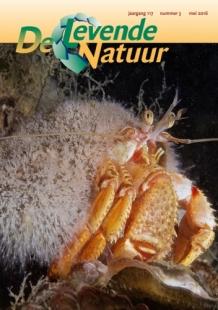De Levende Natuur nummer 3 van 2016 (English summary)
Afbeelding

Public support for nature and nature policy
T.A. de Boer & B.H.M. Elands
Since 1996, a survey has been held every five years to assess the public support for nature conservation. The last survey, which was based on an online panel, was held in 2013. 1500 respondents completed the questionnaire, which was structured around three themes: appreciation of nature, appreciation of nature policy and public engagement with nature. The results show that people have a diverse interpretation of what nature encompasses, both in terms of what nature consists of, but also the way human beings should take care of nature. Nature protection is still considered to be important, although in recent years people give a higher priority to economy and employment. The support for governmental policy measures is large, but decreasing since 2006. Nevertheless, a large majority still considers measures like protecting existing nature area, protecting valuable flora and fauna and environmental education to be (very) important. The national government is considered to be main responsible for nature protection. Citizens might be involved in nature in various ways. The majority of the Dutch are engaged as user of green spaces, mainly for recreational purposes. A smaller part of the Dutch population is also politically and physically active in nature conservation. One in five citizens is not or hardly engaged. While the public support for nature policy is slightly declining, public engagement with nature is growing since 2006.
More information on species richness from North Sea benthos monitoring
M.A. Faasse
Benthos monitoring on the Dutch part of the North Sea yielded some rare megabenthos species and in addition several smaller species new to the area, attached to empty shells or to megabenthos organisms. New bryozoans for the Netherlands were attached to empty shells and shells of living pelican’s foot Aporrhais pespelecani and new entoprocts were attached to sipunculids and polychaetes. It is concluded that monitoring of soft-bottom benthos may miss up to/about 10% of the species present when organisms growing on megabenthos and shells are not taken into account.
The development of aquatic vegetation in reconstructed infiltration channels in the Oostduinen
C.J.S. Aggenbach, M. Annema, A.J.M. Jansen & H.A.M. Ketelaars
Evides Water company operates an artificial infiltration in the dune area Oostduinen on the island of Goeree. In 1996 the introduction of pre-treatment of the infiltration water drastically lowered the concentration of total-phosphorus and suspended matter. In 1996 and 2001 the infiltration system was completely reconstructed. The infiltration channels were reshaped into quasi natural, shallow water bodies. One of the aims of the measures was to develop a species-rich water plant vegetation (e.g. Charetea vegetation). The first years after reconstruction several aquatic plant species of both nutrient-poor and nutrient-rich conditions appeared. However, most species declined, whereas at the same time a strong increase of periphyton (mainly diatoms) occurred. This paper discusses the causes of the poor development of submerged water macrophytes. Due to the low retention times of the surface water in the channels, the P-load for the vegetation is mainly high despite the low phosphorus concentration of the inlet water. The same is true for dissolved silicate, which stimulates the growth of diatoms. The actual spatial pattern of nutrient-poor plant species matches with the differences in P-loads between channels and within channels. The elongated shape of the channels and the position of water inlets at the channel ends enhance strong gradients in P-loads, with the lowest P-loads far away from the water inlets. Other causes for poor development of aquatic vegetation might be high, toxic concentrations of free sulphides in pore water of the soil, and suspension of calcareous fine silt by waterfowl. Besides a stronger removal of phosphorous by pre-treatment of the infiltration water, the possibilities for operational changes in the infiltration and abstraction system are limited. Moreover, the system is optimized to the recovery of wet dune slack vegetation, which has well developed over large areas.
Sandy shoals for Grey seal pups
A.V. de Groot, S.M.J.M. Brasseur, G.M. Aarts, E.M. Dijkman & R.J. Kirkwood
Increasing numbers of Grey seal pups are born in the Dutch Wadden Sea. Pups are born in November-December, and remain on land for several weeks to be suckled and for a period post-suckling. Engelschhoek, Richel and Griend are the three most important pupping locations and the habitats they provide range from dynamic and unvegetated to sheltered and densely vegetated. We investigated the geomorphology, vegetation and inundation frequency of these sites to assess suitability for Grey seal in the long term. The seals have selected sandy sites with minimal human disturbance, which are bare sand or with grassy vegetation. The presence of dunes and vegetation for shelter from wind and flooding during storms may enhance site selection. However, the limited availability of such sites and the dynamics of the sites available force the seals to adapt to the changing conditions on sandbanks in the Wadden Sea, and future pupping at currently selected sites is hard to predict. There are many other potentially suitable pupping sites along the Dutch coast, such as on larger Wadden Sea islands, particularly if human disturbance is minimized.

